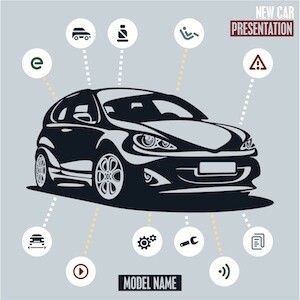

There are a many opportunities with the sensors. Cars outfitted with sensors have the potential to identify unusual events in real-time and to proactively take actions on potential performance issues. A car owner can be informed upfront that a problem is about to happen and could even make an appointment with the nearest car maintenance shop. In the future, when a car owner has linked its agenda to the car, the car can make the appointment directly into the agenda of the car owner and the nearest maintenance shop.
Although that might sound a bit futuristic, the onboard sensors already give the manufactures a lot of information about how the cars are used. How fast someone drives or hits the brakes and how the cars respond to this. The behavior of the driver and the performance of the car can be monitored 24/7. It will help car companies to quickly pinpoint the areas for upgrading and adjust the car appropriately. Time to market for new cars will be shortened.
The self-driving car from Google already is a true data creator. With all the sensors to enable the car to drive without a driver, it generates nearly 1 Gigabyte every second. It uses all that data to know where to drive and how fast to drive. It can even detect a new cigarette butt thrown on the ground and it then knows that a person might appear all of a sudden from behind a corner or car. 1 Gigabyte per second, imagine the amount of data that will create every year: On average, Americans drive 600 hours per year in their car. That equals 2.160.000 seconds or approximately 2 Petabyte of data per car per year. With the amount of cars worldwide to surpass one billion, it is almost unimaginable how much data will be created when Google’s self-driving car will become common on the streets. But Google is not the only company working on self-driving cars. Probably all manufactures are working on a self-driving car and the company Mobileye just raised a staggering $ 400 million to develop self-driving cars.
Improving the supply chain
Using public data as well as data from the CRM database, car manufactures can predict which cars are required when and where. This will help improve the inventory levels as well as reduce costs. If they also know, using the sensors in cars, when cars are about to break down and which parts are required where they can better forecast their parts inventory. This will bring down inventory, optimize the supply chain for manufacturers and dealers and improve customer satisfaction.
That same data can also be used to monitor dealer satisfaction, just like Hertz is doing with their over 8000 dealers worldwide. Monitoring the blogosphere as well as social networks provides a lot of information to monitor dealer satisfaction. When this happens in real-time, complaints and possible media-crises can be solved instantly saving a lot of money and also create happy customers.
Improving the customer experience
There are several other data sources, such as telematics or weather data, that can be also used to understand and monitor driving behavior in order to improve the driving experience. These (real-time) insights can be used in the (re)development of cars to optimize and improve the driving experience. Using sensors within the chairs and monitoring how someone drives, which radio channels he or she listens to as well as other information such as usage of air-conditioning can all be used to build a personal profile that is automatically loaded when a driver ‘registers’ or ‘logs-in’ in a (new) car.
Within a few years it might become possible that algorithms can improve driver behavior by simply providing driving performance improvement recommendations directly on the dashboard and/or the driver’s smartphone app, tailored to the situation the driver is in at that exact moment.
All that data can be combined with social public data to better understand customers. Combining several sources of public data, such as geographical locations, housing, demographics etc can give a 360 degrees view of the customers.
Saving money
When cars are connected to each other and the internet, they will be able to talk to each other. Cars will be able to ‘see’ where other cars or road users are on the road and take action if required. The cars know when a traffic jam is coming up, can even suggest a different routing and optimize the routing to prevent accidents and to save on fuel in the mean time.
The same sensors can track when and where cars are stolen and the can be easily located in order to solve car crimes. The algorithm to understand the personal driving behavior of the main driver can also be used to detect car theft. Whenever the driving pattern unexpectedly changes, police can be notified.
The above-discussed examples are just a few of the many opportunities that are possible with big data. Cars are becoming information-driven organizations and it is not without reason that General Motors insourced 10.000 IT staff to really become a completely information-centric organization. Big data technologies have a lot of potential to improve the automotive industry in many ways. Better driving behavior, better cars, less accidents and happier customers.
image: data from cars/shutterstock